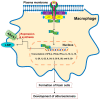Clinical Aspects of Janus Kinase (JAK) Inhibitors in the Cardiovascular System in Patients with Rheumatoid Arthritis
- PMID: 33036382
- PMCID: PMC7583966
- DOI: 10.3390/ijms21197390
Clinical Aspects of Janus Kinase (JAK) Inhibitors in the Cardiovascular System in Patients with Rheumatoid Arthritis
Abstract
Janus kinase (JAK) inhibitors, a novel class of targeted synthetic disease-modifying antirheumatic drugs (DMARDs), have shown their safety and efficacy in rheumatoid arthritis (RA) and are being intensively tested in other autoimmune and inflammatory disorders. Targeting several cytokines with a single small compound leads to blocking the physiological response of hundreds of genes, thereby providing the background to stabilize the immune response. Unfortunately, blocking many cytokines with a single drug may also bring some negative consequences. In this review, we focused on the activity of JAK inhibitors in the cardiovascular system of patients with RA. Special emphasis was put on the modification of heart performance, progression of atherosclerosis, lipid profile disturbance, and risk of thromboembolic complications. We also discussed potential pathophysiological mechanisms that may be responsible for such JAK inhibitor-associated side effects.
Keywords: JAK/STAT; Janus kinase inhibitors; cardiovascular system; cytokines; heart failure; lipid profile disturbances; rheumatoid arthritis; thromboembolic.
Conflict of interest statement
The authors declare no conflict of interest.
Figures



References
Publication types
MeSH terms
Substances
Grants and funding
LinkOut - more resources
Full Text Sources
Other Literature Sources
Medical

